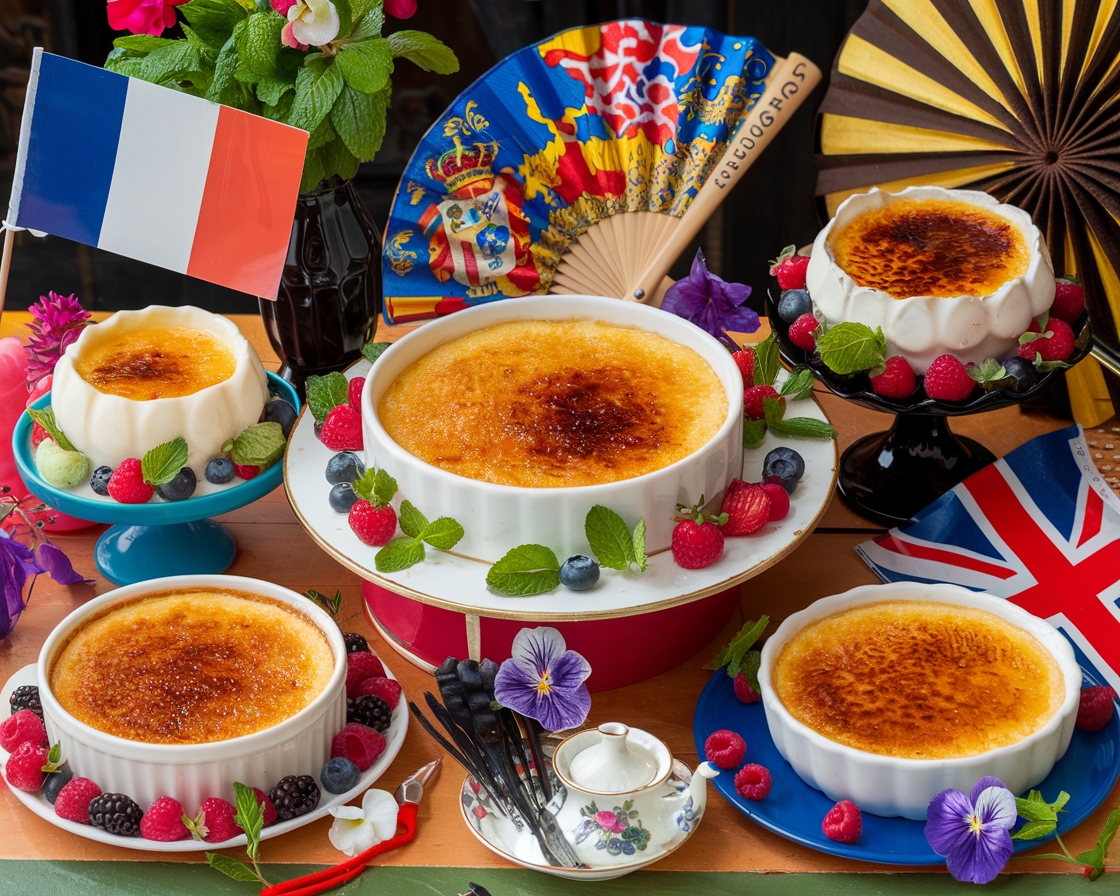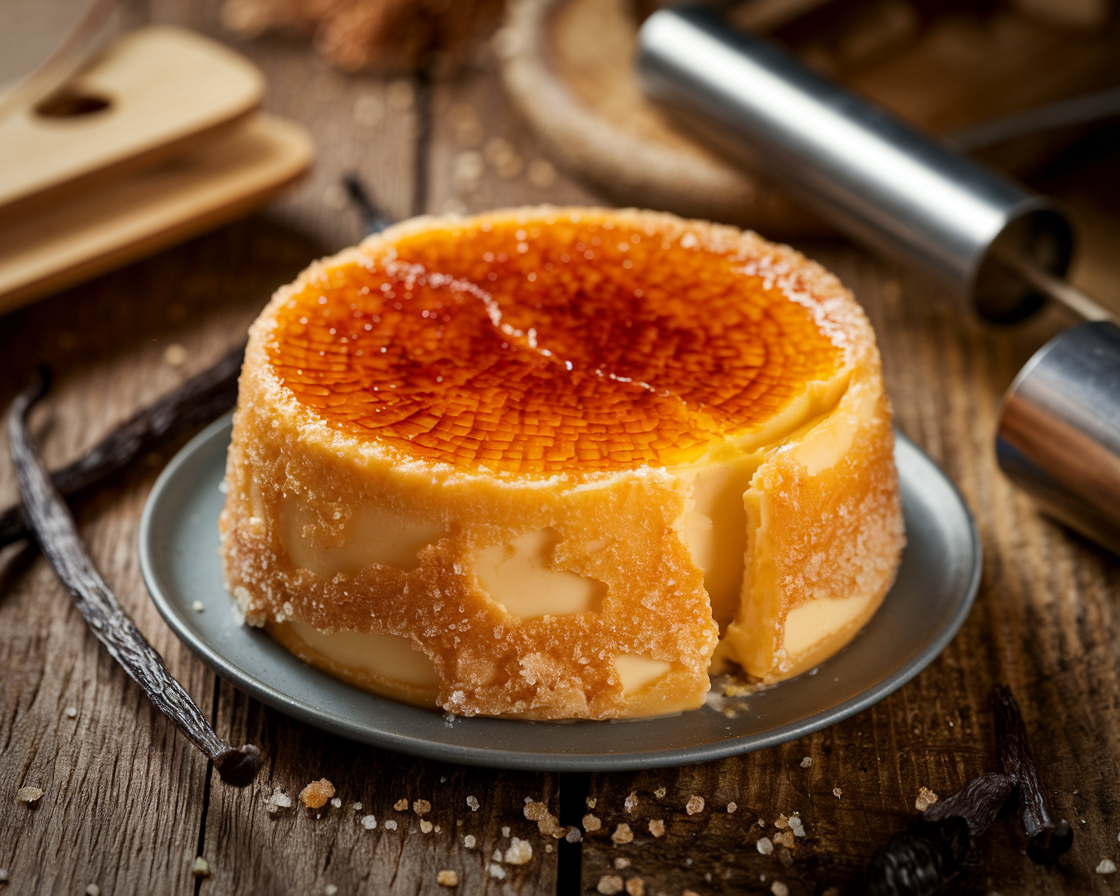Table of contents
- Introduction to Crème Brûlée
- Key Ingredients of Crème Brûlée
- Additional Variations and Enhancements
- How to Make Crème Brûlée at Home
- Common Problems When Making Crème Brûlée
- Pro Tip 📝
- Cultural Impact and Popularity of Crème Brûlée
- Is Crème Brûlée Healthy? Nutritional Overview
- FAQs About Crème Brûlée Ingredients
Have you ever cracked into the caramelized top of a crème brûlée, only to discover the smooth, velvety custard underneath? This French dessert isn’t just delicious—it’s an art form. But what makes it so special? What is crème brûlée mostly made of? Let’s dig in and uncover the secrets behind this dessert’s magic.
Introduction to Crème Brûlée
Crème brûlée is like the dessert world’s version of a mystery novel—simple ingredients, but they come together to create something extraordinary. This decadent treat is beloved for its silky texture and the satisfying crack of its sugar crust. Whether you’ve enjoyed it at a fancy restaurant or dreamed of making it at home, crème brûlée has a universal appeal.
The History and Origins of Crème Brûlée
Ever wondered where crème brûlée came from? Surprisingly, its origins are a bit of a debate! Some say it’s French (the name means “burnt cream” in French), but there are claims it has English and Spanish roots, too. The earliest recipes date back to the 17th century. Talk about a dessert with a rich history, right?
Why Crème Brûlée Is a Timeless Dessert
Why has crème brûlée stood the test of time? The answer lies in its perfect balance. The creamy custard and crispy caramelized top offer a texture contrast that’s hard to beat. Plus, it’s endlessly customizable. Whether you prefer it classic or infused with exotic flavors, there’s a crème brûlée for everyone.
Key Ingredients of Crème Brûlée
Crème brûlée isn’t made of anything fancy—it’s proof that simplicity can be stunning. Let’s break down the main ingredients that create this masterpiece.
The Essential Role of Heavy Cream 🥛
Heavy cream is the backbone of crème brûlée. It gives the custard its rich, luscious texture. Without it, you’d end up with something flat and lifeless. The cream also helps balance the sweetness, making each bite smooth and satisfying.
Egg Yolks: The Custard Foundation 🥚
Egg yolks are the unsung heroes here. They act as a thickening agent, turning the cream and sugar mixture into the custard we all know and love. Skip the whites—this dessert is all about the golden goodness of yolks.
Sugar: Sweetness and Caramelization 🍬
Sugar plays a double role. First, it sweetens the custard, creating that melt-in-your-mouth experience. Second, when sprinkled on top and torched, it transforms into the caramelized crust that’s so satisfying to crack.
“The sugar crust isn’t just a topping; it’s the dessert’s crown jewel, offering crunch in every bite.”
Vanilla: The Classic Flavor Profile 🌸
Vanilla is what ties it all together. Whether you use vanilla beans, paste, or extract, it adds warmth and depth to the custard. Think of it as the glue that brings the other flavors to life.
Table: Ingredients and Quantities
| Ingredient | Quantity |
|---|---|
| Heavy Cream | 2 cups |
| Egg Yolks | 5 large |
| Sugar (Custard) | 1/3 cup |
| Sugar (Topping) | 1/4 cup |
| Vanilla Extract | 1 teaspoon |
Pro Tip 📝
Always use fresh, high-quality ingredients for the best results. It’s a simple dessert, so every ingredient matters!
Additional Variations and Enhancements
Crème brûlée might be a classic, but who says you can’t put your own spin on it? While the traditional version relies on vanilla, there are countless ways to elevate this dessert. Let’s explore some creative variations that bring exciting twists to your crème brûlée game.
Flavoring Crème Brûlée with Citrus or Spices
Want to add a zesty kick? Infuse the cream with orange or lemon zest for a citrusy twist. Spices like cinnamon, cardamom, or nutmeg can transform the custard into a warm, comforting treat. These small tweaks give crème brûlée a seasonal flair—perfect for impressing guests during the holidays.
Chocolate and Coffee Crème Brûlée Variations
Chocolate lovers, rejoice! Adding melted dark chocolate to the custard creates a rich, indulgent version of crème brûlée. And for coffee enthusiasts, a splash of espresso in the cream takes this dessert to another level. Think of it as a café-style dessert with a crunchy caramelized twist.
“Crème brûlée is like a blank canvas—simple ingredients, endless possibilities.”
How to Make Crème Brûlée at Home
Now that we’ve covered the flavors, it’s time to make your own! Don’t worry—it’s easier than you think. Just follow these step-by-step instructions, and you’ll be cracking into your homemade crème brûlée in no time.
Step-by-Step Recipe for Beginners 🧑🍳
- Preheat Your Oven: Set it to 325°F (160°C). This ensures your custard bakes gently, avoiding curdling.
- Heat the Cream: In a saucepan, warm the heavy cream over medium heat. If you’re using vanilla beans, add them now to infuse their flavor.
- Mix the Yolks and Sugar: In a bowl, whisk egg yolks and sugar until pale and creamy. This creates the custard’s foundation.
- Combine: Gradually pour the warm cream into the egg mixture while whisking constantly. This step tempers the eggs, preventing them from scrambling.
- Strain: For a super-smooth custard, strain the mixture through a fine sieve.
- Pour into Ramekins: Divide the custard evenly among ramekins. Place them in a baking dish and add hot water halfway up the sides to create a water bath.
- Bake: Bake for 30–40 minutes or until the custards are set but still jiggly in the center.
- Chill: Let the custards cool, then refrigerate for at least 4 hours (overnight is best).
- Caramelize: Sprinkle sugar on top and use a kitchen torch to caramelize it. If you don’t have a torch, broil the ramekins in the oven briefly.
Tips for Achieving the Perfect Caramelized Top
- Use superfine sugar for even caramelization.
- Torch in circular motions to avoid burning one spot.
- Let the caramelized sugar cool for a minute to create that iconic crack.
Common Problems When Making Crème Brûlée
Making crème brûlée isn’t rocket science, but it comes with its own set of challenges. Let’s tackle some of the most common problems so you can master this dessert with confidence.
Why Does My Custard Turn Out Runny?
A runny custard often means it wasn’t baked long enough. Make sure to bake until the edges are set, and the center has a slight jiggle. Also, double-check your oven temperature—it can be a sneaky culprit.
How to Avoid Overcooking the Custard
Overcooked custard turns grainy and loses its silky texture. To avoid this, always bake using a water bath and keep a close eye on the baking time. If in doubt, slightly underbake—it will continue to set as it cools.
“Custard is all about timing—nail that, and you’ve got a dessert to remember.”
Solutions for Achieving an Even Caramelized Layer
Uneven caramelization can be frustrating. To fix this, make sure the sugar layer is even and thin. When using a torch, move it in steady motions, and don’t hold it too close to the sugar.
Pro Tip 📝
Always let your crème brûlée rest for a few minutes after caramelizing the top. This allows the sugar to harden fully, giving you that satisfying crack with each bite.
Cultural Impact and Popularity of Crème Brûlée
Crème brûlée isn’t just a dessert—it’s a culinary icon. From its origins in fine dining establishments to its place on dessert menus worldwide, this treat has a cultural significance that goes beyond its ingredients. Let’s dive into what makes crème brûlée a symbol of indulgence and sophistication.
Crème Brûlée Around the World 🌍
Although it’s traditionally French, crème brûlée has found a home in cuisines across the globe. In Spain, its cousin “crema catalana” features a similar custard base but with citrus and cinnamon flavors. Meanwhile, in Britain, “burnt cream” has been enjoyed for centuries, especially in Cambridge. Despite these variations, the allure of cracking that caramelized sugar is universal.
Why It Remains a Favorite in Fine Dining 🍽️
Have you noticed how crème brûlée often appears on high-end menus? Its elegant presentation, combined with its rich flavors, makes it a show-stopper. It’s also deceptively simple to prepare, allowing chefs to focus on perfecting its texture and flavors. Plus, who doesn’t love a dessert that combines drama (hello, torching the sugar!) with decadence?

“Crème brûlée isn’t just a dessert; it’s an experience that starts with the first crack of caramelized sugar.”
Is Crème Brûlée Healthy? Nutritional Overview
While crème brûlée is undeniably delicious, you might be wondering if it fits into a healthy lifestyle. Let’s break down its nutritional profile to help you decide.
Calorie and Macronutrient Breakdown 🔍
Crème brûlée is rich, so it’s no surprise that it’s calorie-dense. Here’s a typical nutritional breakdown per serving (based on a classic recipe):
| Nutrient | Amount (per serving) |
|---|---|
| Calories | 250–300 kcal |
| Fat | 20–25 g |
| Carbohydrates | 20–25 g |
| Protein | 4–6 g |
While it’s not exactly a low-calorie option, it’s worth indulging in moderation.
Healthier Alternatives for Crème Brûlée 🌿
If you’re looking for lighter options, here are a few ideas:
- Swap heavy cream for coconut milk to reduce saturated fats.
- Use a sugar substitute like erythritol for the custard and topping.
- Try baking smaller portions for built-in portion control.
“Dessert is meant to be enjoyed—balance is the key to savoring every bite without guilt.”
FAQs About Crème Brûlée Ingredients
Curious about substitutions or troubleshooting your crème brûlée? Here are some common questions answered.
Can I Use Milk Instead of Heavy Cream? 🥛
Yes, but keep in mind that milk has a lower fat content, which can affect the texture. Your custard might be less creamy, but it will still taste delicious.
What Happens if I Use Whole Eggs Instead of Yolks? 🥚
Using whole eggs will make the custard firmer and less velvety. Stick to yolks if you’re after that classic crème brûlée silkiness.
Can I Make Crème Brûlée Without a Torch? 🔥
Absolutely! If you don’t have a kitchen torch, you can use your oven’s broiler. Just keep a close eye on it to prevent burning the sugar.
| Question | Answer |
|---|---|
| Can I use milk instead of cream? | Yes, but expect a less creamy texture. |
| Can I replace sugar with honey? | Yes, but it might alter the flavor. |
| Do I need a water bath? | Yes, for even cooking and no curdling. |
Crème brûlée is a timeless dessert that combines a rich custard base with a perfectly caramelized sugar crust. To achieve the ideal texture and flavor, it’s essential to use the right type of cream. For an in-depth guide on selecting the best cream for your crème brûlée, you can refer to our article: What Type of Cream is Best for Crème Brûlée?. Additionally, mastering the techniques to create this dessert can elevate your culinary skills. Discover the secrets to perfecting crème brûlée in our comprehensive guide: What is the Secret to Crème Brûlée? A Comprehensive Guide. For those looking to explore a savory twist on this classic, our Crab Brulee Recipe: Luxurious and Easy to Make offers a delightful variation. Each of these articles provides valuable insights and step-by-step instructions to help you create the perfect crème brûlée at home.
And there you have it—a complete deep dive into crème brûlée, from its history and key ingredients to variations and troubleshooting tips. Now that you know all the secrets, it’s time to whip up this timeless dessert and enjoy its magic. So, are you ready to crack into your own masterpiece? 🍮

